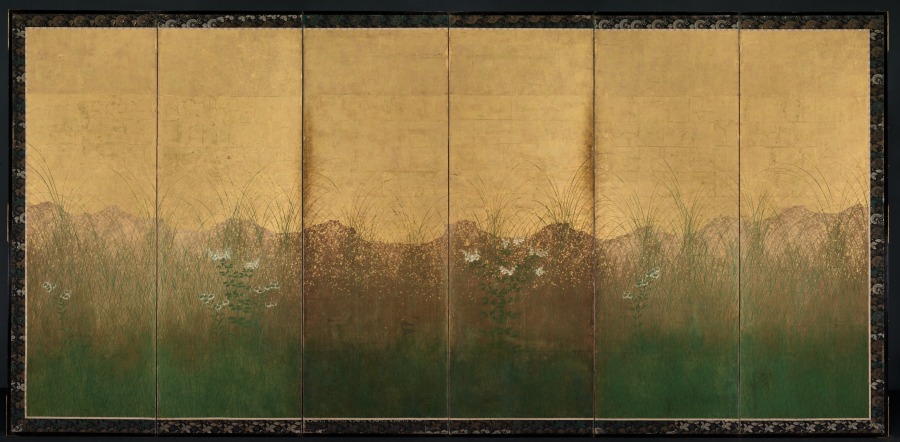| schema:description 10 | "id: 161672" |
| schema:description | "tombstone: Autumn Evening with Full Moon on Musashino Plain, early 1600s. Japan, Edo period (1615-1868). One of a pair of six-fold screens; ink, color, and gold and silver foil on gilded paper; image: 170.2 x 346.7 cm (67 x 136 1/2 in.). The Cleveland Museum of Art, John L. Severance Fund 2000.4.1...(more)" |
| schema:description | "creditline: John L. Severance Fund" |
| schema:description | "measurements: Image: 170.2 x 346.7 cm (67 x 136 1/2 in.)" |
| schema:description | "digital_description: Tall grasses and autumn flowers reach out of thick green undergrowth in this depiction of the plain of Musashi, a site famous from classical Japanese poetry. A silver disc, now tarnished, represents the full moon. Flecks of cut-gold foil in the sky evoke the day’s passage into night. Once a wilderness with a vast horizon, Musashi is now densely populated....(more)" |
| schema:description | "type: Painting" |
| schema:description | "wall_description: The Japanese view of the world is a temporal one, guided in its major rhythms by the seasons. Poems of the four seasons have been crafted since the ninth century and compiled into anthologies that, in turn, spawned a legion of new poems and anthologies that, cumulatively, are regarded as the origins of Japanese literature. Of those poems, those with autumn themes predominate. The close association of the changing seasons and the stages of life, and the corresponding references to specific emotions, created through the centuries a framework in literature and then visual imagery for developing a common, recognizable vocabulary of flora. Specific flowering plants became signposts of a season, perhaps a place, and certainly references to an emotional landscape synchronous with the journey of life. The millennia-old exploration and codification of this terrain has resulted in such well-recognized phenomena as flower arranging, gardening, and architecture--all of which reflect enduring attempts to incorporate nature into everyday human existence. Gatherings such as the "seven grasses of autumn" (or the "seven grasses of spring") evolved out of their close association with harvest (or planting) festivals. The sense of well-being and accommodation in a place is remarkable in these byøbu. A broad vista of golden brown wild grasses reaching out of dense green undergrowth toward a blank gold-foil sky sets the stage. Dispersed among the crisscrossing network of grass blades are isolated clumps of autumn flowers. The perspective is low, and any suggestions of far distance are concealed in favor of immediate visual and emotional engagement. A large tarnished disc of silver quietly announces the arrival of the moon, rising above a field of grasses taller than the traveler through this wild plain. Flecks of cut-gold foil descend from the receding sky to help illuminate the day's passage into night in this elegant, optimistic view of nature. The uniformity of color, suppression of spatial references, and almost ceaseless linear rhythms coalesce with determined grace in this alluring but somewhat artificial disclosure of natural beauty. We see the autumnal plain "cleaned up," as if offering a paradigm for achieving the human equivalent. Here design merges with nature in a dance in which the two sway to the words and imagery of an anonymous tenth-century poetic muse: Japanese poetry has its seeds in the human heart and takes form in the countless leaves that are words....(more)" |
| schema:description | "culture: Japan, Edo period (1615-1868)" |
| schema:description | "collection: ASIAN - Folding screen" |
| schema:description | "technique: One of a pair of six-fold screens; ink, color, and gold and silver foil on gilded paper" |

